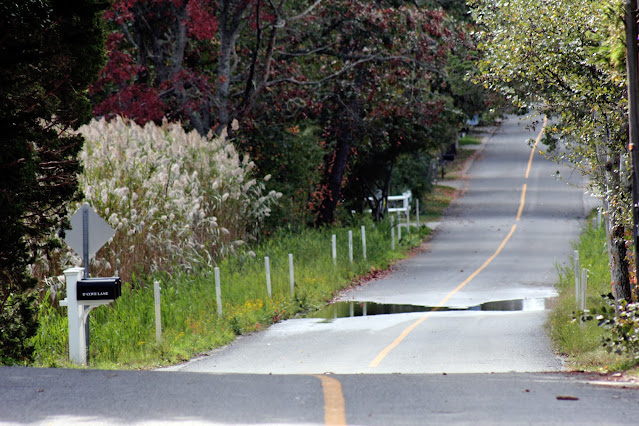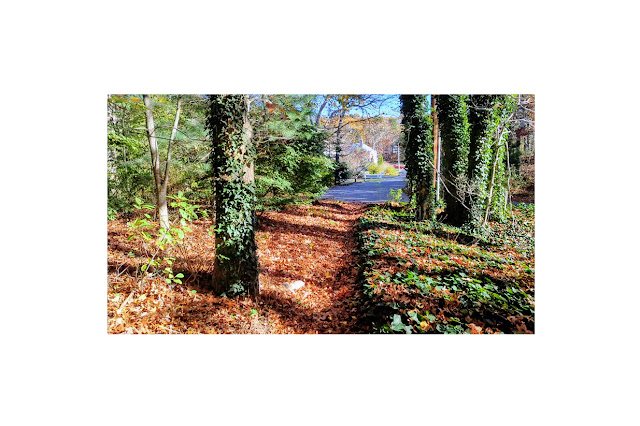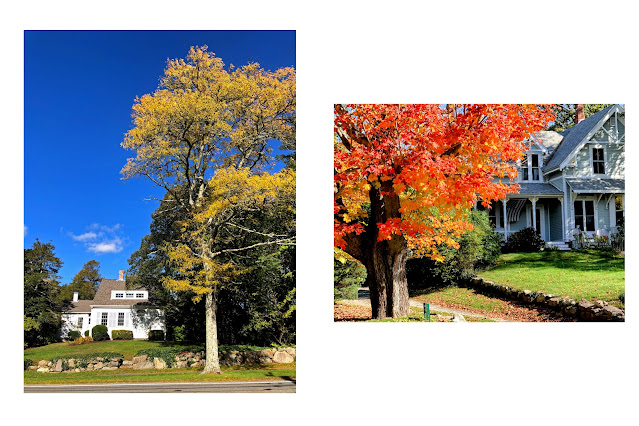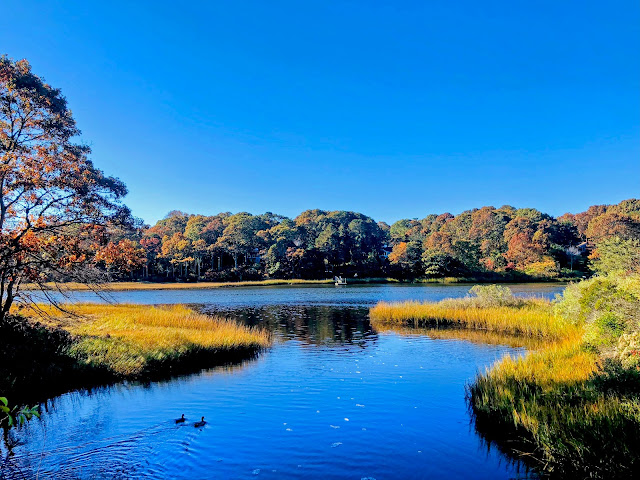End of fall, Sandwich
Step into the enchanting world of Cape Cod's autumn splendor through the lens of an experienced traveler and photographer. This photographic exhibition offers a captivating glimpse into the timeless beauty of this iconic destination. With a collection of stunning images captured during the fall season, the exhibition showcases the vibrant transformation of Cape Cod's landscape, highlighting its majestic trees, winding roads, tranquil seascapes, and serene lagoons.
Im a dedicated admirer of Cape Cod, has made numerous visits to this picturesque region, forging a deep connection with its seasonal transitions. Their artistry portrays the serene harmony between nature and human presence, capturing the essence of Cape Cod's unique charm during autumn. Through these meticulously composed photographs, the exhibition invites you to witness the kaleidoscope of colors as trees don their golden and crimson attire, creating a breathtaking spectacle. You'll be guided along the meandering roads that beckon exploration, capturing the essence of wandering through the Cape's idyllic landscapes. The vast and restless sea meets the calm and secluded lagoons in a juxtaposition of natural beauty and serenity.
"Autumn in Cape Cod: A Visual Journey" is an ode to the beauty of this coastal gem, an homage to the seasons, and an invitation to explore the serene allure of Cape Cod. Join us on this voyage through the lens and savor the timeless magic of autumn in Cape Cod.
Acer saccharum - Sugar maple
The Acer saccharum, commonly known as the sugar maple, is a distinctive tree found on Cape Cod. These trees are known for their stunning fall foliage, with leaves turning brilliant shades of red, orange, and yellow, adding a burst of color to the Cape's landscape during the autumn months. Sugar maples are appreciated not only for their aesthetic value but also for their economic significance in maple syrup production. While not as common as in some other parts of the United States, sugar maples on Cape Cod contribute to the region's biodiversity and offer a picturesque display of nature's beauty during the fall season.
Autumn contrast
Low tide at East Sandwich revealing the Cordgrass
Cordgrass, scientifically known as Spartina alterniflora, is a vital and resilient plant species found in the coastal ecosystems of Cape Cod, Massachusetts. This salt-tolerant, grassy perennial plays a crucial role in maintaining the health and stability of the region's delicate coastal environments. Cordgrass thrives in the intertidal zones, where it forms dense stands along the shoreline, creating a natural barrier that helps protect against erosion. Its extensive root system binds the soil, preventing it from washing away during high tides and storms. In doing so, cordgrass helps to safeguard the coastline, protecting both natural habitats and human infrastructure.
This remarkable plant also provides essential habitat and sustenance for a variety of wildlife species. Its dense thickets offer shelter and nesting sites for birds, while the decomposing plant material contributes to the food web of the coastal ecosystem. Cordgrass is an unsung hero of Cape Cod's coastal environment, working quietly but effectively to maintain the delicate balance between land and sea. Its presence is a testament to the intricate and interconnected web of life that makes this region so unique and ecologically diverse.
East Sandwich
Roads
As autumn descends upon Cape Cod, its well-traveled roads take on a different character. The bustling summer crowds have departed, leaving behind a sense of tranquil isolation that is uniquely enchanting. The lonely roads of Cape Cod in the fall become a canvas of solitude, where nature and introspection harmonize. The winding byways that ribbon through the landscape, flanked by trees resplendent in their fiery foliage, beckon travelers to explore at their own pace. These roads, often bustling with activity during the summer, now offer a serene sanctuary for those who seek to embrace the quieter side of Cape Cod.
With each bend in the road, a new vista unfolds, as the surrounding forests transition into a breathtaking palette of oranges, reds, and yellows. The loneliness of these roads becomes a welcoming friend, allowing for uninterrupted contemplation of the beauty that nature so generously bestows upon Cape Cod during this season. As you navigate these lonely roads, the whispers of the ocean in the distance and the rustling of leaves underfoot create a soothing symphony. It's a time when the world slows down, and Cape Cod reveals its intimate secrets to those who venture to explore the less-traveled paths.
Circuit Rd, West Yarmouth
Lonely roads in Cape Cod in the fall offer not just a journey through captivating landscapes but also a journey within. They provide a space for introspection, allowing you to connect with the deep tranquility of the season. The world may be quieter, but the beauty is anything but diminished. Whether you're a first-time visitor or a seasoned traveler, the lonely roads of Cape Cod in autumn hold a quiet allure that draws you in, urging you to savor the solitude, the stunning scenery, and the subtle magic of this timeless destination.
Back in The Cape
I returned to Cape Cod during the fall of 2022 to only take photographs and enjoy the tranquility that the fresh season offers when the summer tourism has already disappeared. I spent a month taking photos and riding my bike throughout the Cape from top to end, I only missed a few towns, but they have all been photographed in the past.
Previously in 2021 I visited Cape Cod only in the summer and took hundreds of photos at places I had never seen before that I only scheduled to visit. From that trip I made my second photographic exhibition about Cape Cod: "Cape Cod, end of summer" (See link below)
I was also in Cape Cod in the summer and fall of 2015 photographing some areas that I knew and also having the opportunity to travel north and reach New Hampshire to also photograph the autumn foliage like I had never seen before. During the change from summer to autumn I was able to see with my own eyes the transformation of colours, something I had never seen before. Well, in that time I had only been in the summer of 2004 and I didn't get to see the fall. From those photos i made my first exhibition about Cape Cod: "New England a Change of Seasons" (See link below)
The invasive Common Reed
My secret shortcut in Centerville
American Beach Grass, Ammophila Breviligulata (Barnstable)
Ammophila Breviligulata (East Sandwich)
Ammophila breviligulata, commonly known as American beachgrass, plays a crucial role in stabilizing the coastal dunes of Cape Cod. This native grass is well-adapted to the harsh beach environment, with its long, tough rhizomes that help bind sand and create dune structures. Its deep-rooted system also aids in erosion control, protecting the fragile coastal ecosystem. The presence of Ammophila breviligulata is essential for preserving the unique landscapes of Cape Cod and safeguarding against the forces of coastal erosion.
Phragmites Australis
The common reed, known scientifically as Phragmites australis, is a plant species that has garnered attention at Cape Cod for its invasive nature and impact on the region's ecosystems. While this reed is not native to Cape Cod, it has established a robust presence, often outcompeting native vegetation and altering the landscape. Common reed is recognized by its tall, dense stands of feathery plumes that tower along waterways and wetland areas. Its rapid spread is concerning because it can displace native vegetation and disrupt the natural balance of the region's ecosystems. This can have negative consequences for wildlife that depend on native plants for habitat and sustenance.
Efforts to manage and control common reed at Cape Cod have been ongoing, as its unchecked growth can lead to ecological imbalances and hinder the natural beauty of the landscape. Conservationists and environmental organizations are working to mitigate its impact and protect the unique biodiversity of the Cape. While the common reed is a striking and resilient plant, its invasive nature at Cape Cod highlights the ongoing challenges of preserving the region's native ecosystems and ensuring the delicate balance between native and non-native species.
Colors in Lumbert Pond, Centerville
Reflections in Bumps River, Centerville
Lumbert Pond, Centerville
Honey Locust and Norway maple, Barnstable Village
The Honey Locust (Gleditsia triacanthos) is a unique and adaptable tree found in Cape Cod. Known for its delicate, pinnately compound leaves and distinctively long, twisted seed pods, this tree offers a striking appearance. Honey locusts are well-suited to the Cape's environment, tolerating a range of soil types and growing conditions. Their dappled shade and open canopy make them popular choices for landscaping and street planting. While not native to Cape Cod, the honey locust has found a home in the region, contributing to its diverse urban and suburban greenery.
The Acer platanoides, or Norway maple, is a non-native tree species found on Cape Cod. These trees are appreciated for their broad, dense canopies and distinctive, palmately lobed leaves. While they provide abundant shade and a picturesque presence, Norway maples have been met with some controversy due to their aggressive growth and competition with native vegetation. Despite this, Norway maples can be seen in various parts of Cape Cod, particularly in urban and suburban areas. They contribute to the region's arboreal diversity and offer a different aspect of beauty with their vibrant, green foliage in the summer and a spectrum of yellow to orange hues in the fall.
Grey's Beach Viewpoint
Cape Cod's tides are not merely a predictable natural phenomenon but are the region's timekeepers, shaping life along its coastal shores. The ebb and flow of the tides in Cape Cod are an integral part of the daily rhythm, influencing everything from fishing to beachcombing and coastal ecology. The tides in Cape Cod are renowned for their consistency and significance. With the Atlantic Ocean to the east and Cape Cod Bay to the west, the Cape experiences two high tides and two low tides each day. This tidal dance is not only a marvel to observe but also a practical aspect of life for the local community.
Tides dictate the availability of clamming and shellfishing, influence the behavior of marine life, and sculpt the ever-changing landscape of Cape Cod's beaches. As the tides shift, they reveal hidden treasures, reshape sandy shores, and provide a dynamic backdrop for both residents and visitors. From the peaceful tranquility of a low tide morning beach walk to the thrill of watching waves crash against the shore during high tide, Cape Cod's tides offer a mesmerizing display of nature's power and beauty. They serve as a reminder of the timeless connection between the Cape and the sea, where the ebb and flow of the tides keep Cape Cod's heart beating in rhythm with the ocean.
Lone Ring necked Duck
This digital photography exhibition, is a reflect of the breathtaking beauty of autumn in Cape Cod, a place where nature's artistry knows no bounds. This exhibition has encapsulated the essence of this remarkable season, celebrating the elements, the majestic trees, the unique climate, and the unmatched tranquility that defines this region.
The photos on display have transported us to the tranquil shores of Cape Cod, where the golden hues of autumn leaves paint a mesmerizing canvas against the azure sky. The whispering winds, the gentle rustle of leaves, and the crisp air have all been masterfully captured, evoking a sense of serenity that only Cape Cod can offer. The mighty oaks and slender maples have stood as silent sentinels, their vibrant foliage mirroring the warmth of the Cape's welcoming community. Each photograph in this exhibition serves as a tribute to the resilient trees, pillars of this landscape's enduring beauty.
Almost winter
The ever-changing climate of Cape Cod, with its cool breezes and vivid sunsets, has been a recurring motif throughout this display. These images remind us of the undeniable connection between this place and the seasons, each change representing the beauty of transformation. In closing, let us remember the tranquility that Cape Cod brings to all who visit, as captured through the lens of these talented photographers. May these memories linger in our hearts as we say farewell to this exhibition, a visual ode to the splendors of autumn in Cape Cod. Thank you for joining us on this artistic journey, and we hope these images continue to inspire you in the years to come.
Christmas is almost here
Other Cape Cod Exhibitions
Click link below






















































No hay comentarios.:
Publicar un comentario